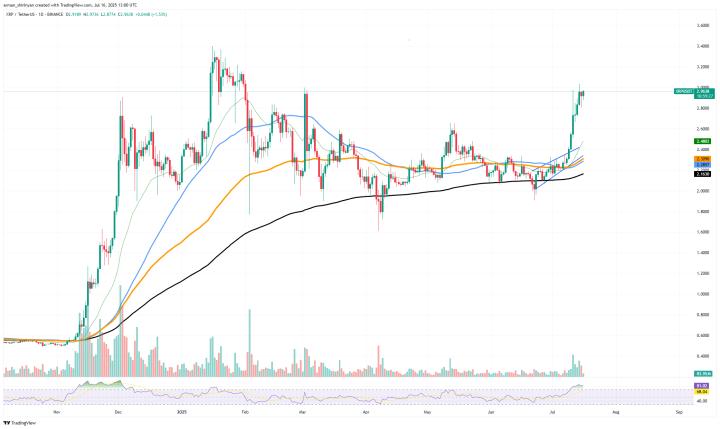Recently, friends focusing on the AI infrastructure track may have noticed that @AethirCloud has delivered an annual ARR of $141 million, with GPU utilization reaching 70%. Meanwhile, $ATH has been listed on Solana, undoubtedly selecting a more suitable battlefield for developing DePIN? Let's discuss Aethir's recent situation: 1) As one of the earliest AI computing power aggregation platforms, Aethir has already aggregated 430,000 high-performance GPU containers from 94 countries globally, including the latest H100s, B200s, and other enterprise-level chips. This is undoubtedly a prerequisite for developing subsequent platform functions. The reason why GPU providers are willing to connect even expensive enterprise-level hardware to the Aethir network is mainly due to its well-designed incentive mechanism. First, there's a dual revenue guarantee. GPU providers earn device online time rewards through PoC (Proof of Capacity) and actual usage rewards through PoD (Proof of Delivery). This design allows idle computing power to generate revenue while encouraging high-quality service provision, adopting a "pay-as-you-go + continuous incentive" model that is more attractive to GPU providers. Additionally, its revenue distribution is transparent enough. When customers book computing power with ATH, 80% is directly distributed to GPU providers, with only 20% going to the foundation. In traditional cloud service provider cost structures, hardware providers usually cannot receive such a high share. More ingeniously, its "shared treasury" design allows new Cloud Hosts to join the network using ATH, lowering the entry barrier while expanding the network scale. This combination of "borrowing + staking + revenue sharing" has directly reconstructed the traditional DePIN participation logic. 2) Aethir has indeed put effort into revenue innovation. Beyond basic computing power revenue, it is simultaneously advancing in several directions: RWAFI direction: Collaborating with @plumenetwork to directly tokenize enterprise-level GPUs, transforming physical hardware into divisible and tradable on-chain assets. Simultaneously launching the native stablecoin AUSD to provide a price anchor for the ecosystem. This is equivalent to turning "computing power leasing" into a REITs-like investment product. NodeFi direction: 91,000 Checker nodes not only receive daily ATH rewards but can also tokenize and trade future revenues through MetaStreet's Yield Pass platform. This means "verification work" itself has been assetized, allowing holders to obtain immediate liquidity without losing long-term returns. Furthermore, Aethir has joined the EigenLayer ecosystem. ATH holders can not only earn computing power revenue but also earn $EIGEN rewards through re-staking. This "multiple staking revenue stacking" directly raises the ATH revenue ceiling and provides more composability in the DeFi ecosystem. The logic behind this combination is clear: Aethir is reconstructing the traditional "selling computing power" business into a multi-layered, composable, and tradable financial product matrix. The previous approach was "having hardware means mining money," now it has become "building a multi-layered revenue structure around hardware." GPUs are no longer just production tools but underlying assets that can be divided, mortgaged, and derived. Verification work is no longer just network maintenance but a source of revenue that can be pre-sold, staked, and liquidity mined. Doesn't this resemble the PayFi track's focus on injecting real economy revenue into DeFi? 3) From actual performance data, Aethir maintains an annual ARR of $141 million amid a sluggish market and has expanded its ecosystem to over 150 AI, gaming, and Web3 enterprises. This business stability is rare in the DePIN track. Moreover, Aethir has pioneered GB200 and B200 cluster services, with chips designed for trillion-parameter models training 4 times faster than H100s. Combined with the ongoing $100 million ecosystem fund investment, the entire flywheel effect is accelerating. Additionally, the Solana ecosystem is rapidly developing in frontier areas like AI Agents, gaming, and RWA, which are precisely the main scenarios for GPU-intensive applications. Against this backdrop, ATH's listing on Solana seems intended to leverage Solana's low transaction fees and high TPS to provide more suitable infrastructure (main battlefield) for DePIN business models requiring numerous micro-transactions. Crucially, this $141 million annual revenue and 150 enterprise customers at least prove the market's real demand for its services. Compared to some DePIN projects still seeking application scenarios, this cash flow-supported business model is evidently more convincing. Of course, long-term success depends on maintaining this growth momentum and whether multi-chain expansion can bring the expected network effects. After all, in the rapidly changing AI computing power market, technological leadership and first-mover advantages are not permanent moats.
This article is machine translated
Show original
Sector:
From Twitter
Disclaimer: The content above is only the author's opinion which does not represent any position of Followin, and is not intended as, and shall not be understood or construed as, investment advice from Followin.
Like
Add to Favorites
Comments
Share





